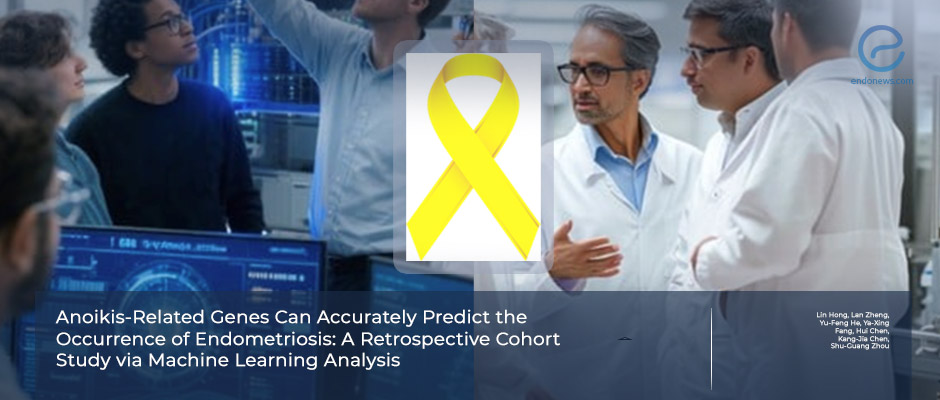Novel Biomarkers for Endometriosis via Anoikis Gene Profiling
Sep 4, 2025
Anoikis Resistance May Hold the Key to Endometriosis Detection
Key Points
Highlights:
- "Anoikis", a form of programmed cell death triggered by cell detachment, is increasingly recognized as central to endometriosis biology.
- Using machine learning, researchers identified four anoikis-related genes with strong diagnostic potential for endometriosis.
- The immune microenvironment analysis revealed altered infiltration of macrophages, mast cells, NK cells, and T cells, offering future therapeutic targets.
Importance:
- Endometriosis diagnosis is currently delayed by 8–12 years on average due to the absence of non-invasive biomarkers.
- A gene-based diagnostic model may provide clinicians with earlier, less invasive, and more accurate diagnostic strategies.
What’s Done Here:
- Data from two database (GSE141549: 179 endometriosis, 43 control -for training; and GSE7305: 10 endometriosis, 10 control, for validation) were evaluated by machine learning.
- A total of 47 differentially expressed anoikis-related genes (DE-ANRGs) were identified.
- Three machine learning approaches (LASSO, Random Forest, SVM-RFE) converged on four diagnostic genes (CAV1, PDK4, CSPG4, SERPINE1).
- A nomogram model integrating these genes achieved excellent predictive accuracy (AUC = 0.981).
- Findings validated in clinical samples (n=10) and the Turku online database.
Key Results:
- All four genes were significantly upregulated in endometriosis patients across datasets.
- ROC curves showed very high diagnostic power.
- Immune landscape analysis revealed higher infiltration of M2 macrophages, mast cells, CD8 T cells, and follicular helper T cells; reduced NK cell activity was noted.
- Functional enrichment implicated PI3K–Akt signaling, focal adhesion, and negative regulation of anoikis as core processes.
Strengths and Limitations:
- Strenghts are being the first large-scale integration of anoikis biology into endometriosis research; multi-step validation: training dataset, external dataset, clinical tissues, and online database; and the combination of machine learning with immune landscape profiling enhances clinical and translational value.
- Limitations are the small size of clinical validation sample size; findings rely on retrospective datasets (larger, prospective cohorts are required), mechanistic role of the four biomarkers in disease progression remains to be elucidated.
From the Editor-in-Chief – EndoNews
"This work highlights how 'anoikis' and machine learning intersect to advance endometriosis diagnostics. Anoikis is a protective form of programmed cell death that eliminates cells when they detach from their natural environment. In diseases like cancer — and as shown here in endometriosis — resistance to anoikis enables cells to survive, migrate, and implant ectopically.
By analyzing large genomic datasets with three independent machine learning approaches, the authors identified a robust four-gene anoikis signature. Their diagnostic model achieved near-perfect accuracy and was validated across multiple datasets, clinical samples, and online resources. The integration of immune profiling further linked anoikis resistance with dysregulated immunity, underscoring the systemic nature of the disease.
Rather than replacing surgery, these findings raise the exciting possibility that molecular signatures may one day support earlier recognition of endometriosis and help reduce today’s long diagnostic delays. Earlier suspicion and referral could, in turn, optimize the timing of both medical and surgical therapies. For researchers, they mark a starting point for unraveling how anoikis resistance drives lesion survival and progression.
This is a landmark contribution that reframes endometriosis not just as a disorder of misplaced tissue, but as a disease of altered cell-death biology, with diagnostic and therapeutic implications."
Lay Summary
Endometriosis is notoriously difficult to diagnose early. Currently, diagnosis often requires surgery, leading to years of delay. A new study published in Biochemical Genetics introduces a potential breakthrough: the use of "anoikis-related genes" — genes linked to a form of programmed cell death that occurs when cells detach from their normal environment. In endometriosis, resistance to anoikis may allow displaced cells to survive and implant in new sites, fueling disease progression.
In this study, researchers used machine learning algorithms to analyze large-scale gene expression datasets. Three independent approaches — LASSO regression, Random Forest, and Support Vector Machine–Recursive Feature Elimination — all converged on the same four genes (CAV1, PDK4, CSPG4, and SERPINE1) as the strongest diagnostic markers.
The team then built a diagnostic model, a nomogram, based on these markers, achieving nearly perfect accuracy in distinguishing women with endometriosis from controls. Importantly, the findings were validated across multiple datasets, a small clinical cohort, and the Turku Endometriosis Database, lending robustness to the results.
Beyond gene markers, immune profiling revealed higher activity of macrophages, mast cells, and T cells, alongside reduced natural killer cell function — pointing toward a broader immune dysregulation in endometriosis.
Although the validation cohort was small and causality cannot yet be proven, this is the first large-scale integration of anoikis biology and machine learning in endometriosis research. The results highlight the promise of gene-based diagnostic tools, which may one day shorten diagnostic delays and reduce the need for invasive surgical confirmation.

